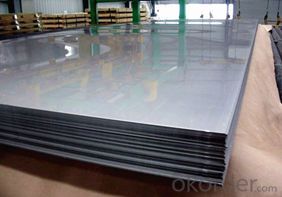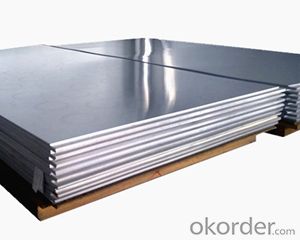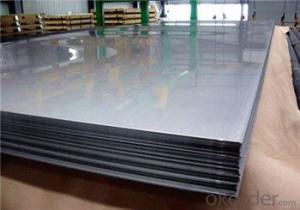High Quality 3003 Aluminum Sheet with a Good Price
- Loading Port:
- Qingdao
- Payment Terms:
- TT OR LC
- Min Order Qty:
- 10000 kg
- Supply Capability:
- 100000 kg/month
OKorder Service Pledge
OKorder Financial Service
You Might Also Like
Item specifice
3003 Aluminum Sheet

3003 Aluminum Sheet Introduction
3003 series aluminum sheet is a common product of aluminum and manganese alloy series. Superior to having manganese alloy elements, which products have excellent anti-rust properties, also known as rust-proof aluminum. Strength is about 10% higher than 1100 aluminum sheet, formability, solubility, corrosion resistance are good. For the processing of parts that require good formability, high corrosion resistance, good weldability, or both require these properties and require more work than 1XXX alloy strength, such as kitchenware, food and chemical products handling Storage equipment, transport of liquid products, tanks, tanks, sheet metal processing of various pressure vessels and pipes General artifacts, heat sinks, cosmetic panels, photocopiers drums, ship timber.
3003 Aluminum Sheet Application Scope
The product is often used in the packaging, mechanical parts, refrigerators, air conditioning and ventilation pipes and other humid environment, the product has a good anti-rust ability.
3003 Aluminum Sheet Picture

3003 Aluminum Sheet Technical parameters
| Alloy | 3003 Aluminum sheet |
| Temper | O,H14,H16,H18,H22,H24,H26 |
| Thickness (mm) | 0.2 ≤ T≤ 1.0 |
| Width (mm) | 820 ≤ W ≤ 1200 |
| Length (mm) | 1000 ≤ L ≤ 3000 |
| Tensile strength σb (MPa) | 90-205 |
| Elongation rate δ10 (%) | 1-20 |
| Chemical Composition | Al :surplus Si :0.6 Cu :0.05-0.2 Zn:0.10 Mn:1.0-1.5 Fe: 0.7 |
| Typical products | Power battery shell material, building curtain wall, insulation materials, bottle caps, beverage caps,etc |
Introduction of our company
Our company is a professional Aluminium Strip manufacturer and Aluminum Circles manufacturers,mainly supply Aluminium Coil,Aluminum Circles,Aluminium discs,Aluminum Sheet,Aluminum Strip, Household Aluminum Foil,Aluminum Foil for Pharmaceutical Packaging,Aluminum Foil Tape,Aluminum Foil for Air Conditioner,Aluminum Foil for Container etc. series of aluminum products, sincerely welcome everyone to visit.
- Q:How do aluminum sheets perform in extreme weather conditions?
- Aluminum sheets are known for their exceptional performance in extreme weather conditions. Due to their inherent properties, aluminum sheets are highly resistant to corrosion and can withstand harsh environmental elements such as rain, snow, and extreme temperature fluctuations. In hot weather, aluminum sheets have the ability to reflect sunlight and dissipate heat, preventing them from warping or deforming. This makes them well-suited for use in areas with high temperatures or direct exposure to sunlight. Similarly, in cold weather, aluminum sheets do not become brittle or lose their strength, making them reliable in freezing temperatures or areas prone to heavy snowfall. They have a low coefficient of thermal expansion, meaning they can withstand contraction and expansion without cracking or becoming damaged. Furthermore, aluminum sheets have excellent resistance to moisture, preventing them from rusting or corroding when exposed to rain or high humidity levels. This makes them ideal for use in coastal areas or regions with heavy rainfall. Aluminum sheets are also lightweight, yet durable, which allows them to withstand high winds and severe storms without compromising their structural integrity. This makes them a preferred choice for applications such as roofing, siding, and outdoor signage in areas prone to hurricanes or strong winds. Overall, aluminum sheets demonstrate remarkable performance in extreme weather conditions, making them a reliable and versatile material for various outdoor applications.
- Q:What are the different methods of surface texturing aluminum sheets?
- Aluminum sheets can be textured in various ways, each with its own advantages and applications. 1. Mechanical Texturing involves using mechanical tools or processes, like brushing, sanding, or embossing, to create patterns or textures on the surface of aluminum sheets. This method is commonly used to achieve a matte or brushed finish, enhancing the appearance and concealing imperfections. 2. Chemical Texturing involves using chemicals to etch the surface of aluminum sheets and create unique patterns or textures. Acid etching, for example, selectively dissolves the surface to create a textured effect. This method is often employed to improve adhesive properties, making the sheets suitable for bonding or coating applications. 3. Anodizing is an electrochemical process that forms a controlled oxide layer on the surface of aluminum sheets. It can create various textures, ranging from smooth and glossy to rough and matte. Anodizing not only enhances the appearance but also improves corrosion resistance and durability. It is commonly used in architecture, consumer products, and automotive parts. 4. Laser Texturing utilizes laser technology to create precise and intricate patterns or textures on aluminum sheets. Laser beams can be accurately controlled to remove material or modify the surface, allowing for highly customized and detailed textures. This method is often utilized in high-end applications, such as jewelry, signage, or interior design. Each texturing method offers unique benefits and is suitable for different applications. The choice depends on factors such as desired texture, durability requirements, aesthetic preferences, and intended use of the aluminum sheets.
- Q:I have been doing this science prac at school and I have received some strange results. I measured the density of this metal, which leads me to believe it is Aluminium. Also, its silvery appearance supports this. When I have attempted to react it with Hydrochloric Acid, Sulfuric Acid and the nitrates/chlorides of a few metals, I have received some odd results.Despite having a high reactivity, the only substance it has reacted with so far out of all of the above is Tin Chloride. Am I doing something wrong? Is it possible that it isn't aluminium and rather a similar metal such as zinc? Thanks in advance :)
- Aluminum is very reactive so what happens is that it has a coat aluminum oxide as soon as it comes in contact with oxygen the outer layer forms aluminum oxide Al2O3. That is why Aluminum does not rust. The Al203 coat protects it.
- Q:is general aluminum sheet fire-proof?
- nonfireproof
- Q:Are aluminum sheets suitable for artistic sculptures?
- Yes, aluminum sheets are suitable for artistic sculptures. Aluminum is a versatile material that offers several advantages for sculpting purposes. Firstly, it is lightweight, making it easier to handle and manipulate. This allows artists to create intricate and detailed sculptures without compromising on structural integrity. Additionally, aluminum is highly malleable, meaning it can be shaped into various forms and contours. This allows artists to experiment with different designs and achieve the desired artistic expression. Furthermore, aluminum is resistant to corrosion and weathering, making it ideal for outdoor sculptures. Its durability ensures that the artwork will withstand the elements and retain its aesthetic appeal over time. Additionally, aluminum sheets can be easily welded or joined together, enabling artists to create larger and more complex sculptures. Overall, aluminum sheets provide artists with a flexible and durable material that allows for creativity and longevity in their sculptural works.
- Q:How do you determine the thickness tolerance of an aluminum sheet?
- To determine the thickness tolerance of an aluminum sheet, several factors need to be considered. Firstly, it is important to refer to the industry standards and specifications for aluminum sheets. These standards typically provide guidelines and tolerances for various thicknesses of aluminum sheets, which can vary depending on the specific alloy and grade of the material. Next, it is crucial to use precise measuring equipment such as calipers or micrometers to accurately measure the thickness of the aluminum sheet. Multiple measurements should be taken at different locations on the sheet to account for any potential variations. Once the measurements are obtained, they should be compared to the specified thickness tolerance provided by the industry standards. The tolerance typically represents the acceptable range within which the actual thickness of the sheet can vary. For instance, if the specified thickness tolerance is ±0.002 inches, it means that the sheet's thickness can vary within this range. If the measured thickness falls within the specified tolerance range, the sheet is considered to be within tolerance. However, if the measured thickness exceeds the upper or lower limit of the tolerance range, it indicates that the sheet is out of tolerance and may not meet the required specifications. In some cases, it may be necessary to consult with the manufacturer or supplier of the aluminum sheet to determine the specific tolerance requirements for a particular application. They can provide additional information and guidance regarding the appropriate thickness tolerance to ensure the sheet meets the intended purpose. Overall, determining the thickness tolerance of an aluminum sheet involves following industry standards, using accurate measuring equipment, and comparing the measured thickness to the specified tolerance range. This helps ensure that the sheet meets the required specifications and can be used effectively in various applications.
- Q:Can aluminum sheets be perforated?
- Yes, aluminum sheets can be perforated. Perforation is a process that involves punching holes or creating a pattern of holes in a material. Aluminum is a versatile and malleable metal that can be easily perforated using various methods such as punching, drilling, or laser cutting. Perforating aluminum sheets can serve multiple purposes such as allowing for airflow, reducing weight, enhancing aesthetics, or creating filtration systems. The size, shape, and arrangement of the perforations can be customized to meet specific requirements and design preferences. Overall, aluminum sheets can be effectively perforated to enhance their functionality and visual appeal.
- Q:Can the aluminum sheets be used for manufacturing food packaging?
- Yes, aluminum sheets can be used for manufacturing food packaging. Aluminum is a popular choice for food packaging due to its various properties. It is lightweight, resistant to corrosion, and has excellent heat conductivity. These qualities make it suitable for preserving the freshness and quality of food products. Additionally, aluminum is impermeable to light, moisture, and oxygen, which helps in extending the shelf life of food. Furthermore, aluminum sheets can be easily molded into different shapes and sizes, allowing for customized packaging solutions. Overall, aluminum sheets are commonly used in the food packaging industry due to their versatility, durability, and ability to maintain the safety and integrity of food products.
- Q:Can aluminum sheets be used for insulation?
- No, aluminum sheets alone cannot be used for insulation as they have low insulation properties. However, they can be used as a reflective layer in combination with other insulation materials to enhance insulation efficiency by reflecting heat or cold.
- Q:Are aluminum sheets suitable for automotive body reinforcements?
- Aluminum sheets, indeed, prove to be a fitting option for reinforcing automotive bodies. With its lightweight properties and exceptional strength-to-weight ratio, aluminum emerges as the perfect candidate for various automotive applications. Furthermore, its resistance to corrosion becomes vital for vehicles navigating through diverse weather conditions and encountering road salts. Moreover, the malleability and weldability of aluminum sheets make them easily adaptable and seamlessly integrated into the body structure. By incorporating aluminum sheets in automotive body reinforcements, the overall weight of the vehicle diminishes, leading to enhanced fuel efficiency and performance. Additionally, the recyclable nature of aluminum aligns perfectly with the automotive industry's growing emphasis on sustainability. Therefore, unquestionably, aluminum sheets represent an ideal choice for reinforcing automotive bodies.
1. Manufacturer Overview |
|
|---|---|
| Location | |
| Year Established | |
| Annual Output Value | |
| Main Markets | |
| Company Certifications | |
2. Manufacturer Certificates |
|
|---|---|
| a) Certification Name | |
| Range | |
| Reference | |
| Validity Period | |
3. Manufacturer Capability |
|
|---|---|
| a)Trade Capacity | |
| Nearest Port | |
| Export Percentage | |
| No.of Employees in Trade Department | |
| Language Spoken: | |
| b)Factory Information | |
| Factory Size: | |
| No. of Production Lines | |
| Contract Manufacturing | |
| Product Price Range | |
Send your message to us
High Quality 3003 Aluminum Sheet with a Good Price
- Loading Port:
- Qingdao
- Payment Terms:
- TT OR LC
- Min Order Qty:
- 10000 kg
- Supply Capability:
- 100000 kg/month
OKorder Service Pledge
OKorder Financial Service
Similar products
New products
Hot products
Related keywords




























